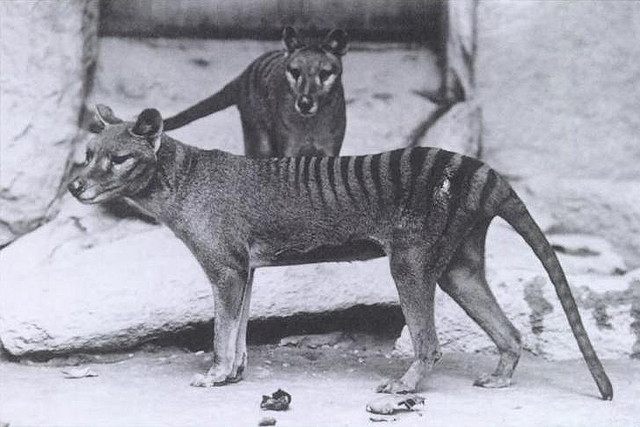This week's Animal Oddity is about a bizarre-looking species called a thylacine that was hunted to extinction based on what now seems to be a false assumption about its behavior.
Thylacines were also known as Tasmanian wolves or Tasmanian tigers based on their somewhat canine appearance (in the case of the former name) and for their striped hides (in the case of the latter one). While in reality they were neither canines nor felines, physically, behaviorally and ecologically, they were probably more cat-like than dog-like despite appearances. Unfortunately, humans treated them according to assumptions made from their appearance alone.
Despite their wolf-like appearance, thylacines were probably unable to subdue prey as large as sheep.
In reality, thylacines were large carnivorous marsupials that were once found over a wide range in Australia. Climate change, the introduction of dingos by humans from Southeast Asia about 4,000 years ago, and other human changes to the landscape are thought to have collectively spelled the doom of the thylacine over the main Australian continent, but they were still clinging to existence on the dingo-less island of Tasmania at the time of European colonization.
It wasn't long, however, before the sheep-herding European settlers put a bounty on the head of these long-jawed predators because they assumed the animals were a threat to their sheep based on their wolf-like appearance. Sadly, it turns out they were probably wrong.
Recent research into the structure and physics of the thylacine body has revealed that despite having a strong bite force, the structure of thylacine skulls, jaws and forelimbs most likely meant that they were solitary ambush hunters that could only subdue and kill animals much smaller than a sheep.
Unfortunately, this research wasn't available to the settlers, and a bounty was put on the head of the thylacine in Tasmania, as was common practice all over the world for any large predator that threatened people or livestock, regardless of whether that threat was real or perceived. As a result, it wasn't long until the thylacine was completely exterminated in the wild.
Despite ongoing reports of sightings in remote wilderness areas, the last known living thylacine died at the Hobart Zoo in 1936.
Get the latest odd animal news, stories, videos and behaviors on my Animal Planet blog, Animal Oddities. Help protect endangered species with the National Wildlife Federation.
Photo by smiteme via Flickr Creative Commons.

